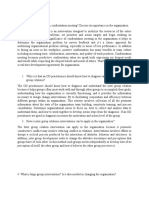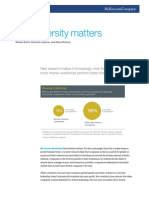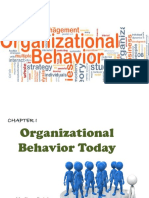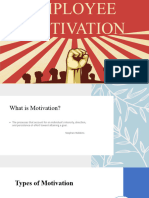Concept of Teams
Concept of Teams
Uploaded by
Tindu SurendranCopyright:
Available Formats
Concept of Teams
Concept of Teams
Uploaded by
Tindu SurendranCopyright
Available Formats
Share this document
Did you find this document useful?
Is this content inappropriate?
Copyright:
Available Formats
Concept of Teams
Concept of Teams
Uploaded by
Tindu SurendranCopyright:
Available Formats
Concept of Teams , Distinguishing team from Groups
Teams are groups of two or more people who interact and influence each other, are mutually accountable for achieving common objectives and perceive themselves as social entity within an organization. All teams exist to fulfil some purposes, such as assembling a product, providing a service, operating a submarine or making an important decision. Team members are held together by their interdependence and need for collaboration to achieve a common goal. All teams require some form of communication so members can coordinate and share common objectives. Team members also influence each other, although some members are more influential than others regarding the teams goals and activities. All teams are groups because they consist of people with a unifying relationship. But not all groups are teams; some groups are just people assembled together. For example, employees who meet for lunch are rarely called teams because they have little or no task. Interdependence (each person called just as easily eat lunch alone) and no purpose beyond their social interaction.
High Performance teams are created with a mission or purpose in mind. This purpose or mission should be expressed in the form of a written charter. Over time teams develop their own set of norms. Norms are rules or guides for team behavior and decision making. The idea of using teams to solve problems and achieve results is based, in part, on a concept that the collective brainpower of a team far exceeds the ability of any manager. Therefore, to a large degree, teams are self-directed. High Performance Teams are also empowered. Teams are motivated by the challenge of achieving dramatic results within a short time-frame. It is quite normal for teams to thrash and churn during the early stages of development. This will usually appear chaotic to outsiders and team members alike. It is also normal for 75 percent of the real work of a team to be accomplished during the last 25 percent of the time alloted. Team members are expected to learn as they work together. Often the scope of work of a team touches or involves the activities of many people beyond the team itself--this external group can be referred to as the community of interest that must be included in the team's communication loop. All teams experience a shortage of resources. This phenomenon must be understood, expected, and available resources defined for the team from the team's inception.
A team comprises a group of people or animals linked in a common purpose. Teams are especially appropriate for conducting tasks that are high in complexity and have many interdependent subtasks. A group in itself does not necessarily constitute a team. Teams normally have members with complementary skills and generate synergy through a coordinated effort which allows each member to maximise his/her strengths and minimise his/her weaknesses. Team members need to learn how to help one another, help other team members realize their true potential, and create an environment that allows everyone to go beyond their limitations.[1]
Thus teams of game players can form (and re-form) to practise their craft. Transport logistics executives can select teams of horses, dogs or oxen for the purpose of conveying goods. Theorists in business in the late 20th century popularised the concept of constructing teams. Differing opinions exist on the efficacy of this new management fad. Some see "team" as a four-letter word: overused and under-useful. Others see it as a panacea that finally realizes the human relations movement's desire to integrate what that movement perceives as best for workers and as best for managers. Still others believe in the effectiveness of teams, but also see them as dangerous because of the potential for exploiting workers in that team effectiveness can rely on peer pressure and peer surveillance. Compare the more structured/skilled concept of a crew, and the advantages of formal and informal partnerships.
Contents
[hide]
1 Team size, composition, and formation 2 Types of teams o 2.1 Independent and interdependent teams o 2.2 Self-managed teams o 2.3 Project teams o 2.4 Sports teams o 2.5 Virtual teams o 2.6 Interdisciplinary and multidisciplinary teams o 2.7 Not all groups are teams o 2.8 From groups to teams 3 See also 4 References
[edit] Team size, composition, and formation
Team size and composition affect the team processes and outcomes. The optimal size (and composition) of teams is debated and will vary depending on the task at hand. At least one study of problem-solving in groups showed an optimal size of groups at four members. Other works estimate the optimal size between 5-12 members.[citation needed] Belbin did extensive research on teams prior to 1990 in the UK that clearly demonstrated that the optimum team size is 8 roles plus a specialist as needed.[2] Fewer than 5 members results in decreased perspectives and diminished creativity. Membership in excess of 12 results in increased conflict and greater potential of sub-groups forming. David Cooperrider suggests that the larger the group, the better. This is because a larger group is able to address concerns of the whole system. So while a large team may be ineffective at performing a given task, Cooperider says that the relevance of that task should be considered, because determining whether the team is effective first requires identifying what needs to be accomplished.
Regarding composition, all teams will have an element of homogeneity and heterogeneity. The more homogeneous the group, the more cohesive it will be. The more heterogeneous the group, the greater the differences in perspective and increased potential for creativity, but also the greater potential for conflict. Team members normally have different roles, like team leader and agents. Large teams can divide into sub-teams according to need. Many teams go through a life-cycle of stages, identified by Bruce Tuckman as: forming, storming, norming, performing and adjourning.
[edit] Types of teams
[edit] Independent and interdependent teams
A rugby union scrum Of particular importance is the concept of different types of teams. A distinction is usually drawn between "independent" and "interdependent" teams. To continue the sports team example, a rugby team is clearly an interdependent team:
no significant task can be accomplished without the help and cooperation of any of the members; within that team members typically specialize in different tasks (running the ball, goal kicking & scrum feeding), and the success of every individual is inextricably bound to the success of the whole team. No rugby player, no matter how talented, has ever won a game by playing alone.
On the other hand, a chess or bowling team is a classic example of an independent team:
matches are played and won, or points are scored, by individuals or partners; every person performs basically the same actions; how one player performs has no direct effect on the performance of the next player. If all team members each perform the same basic tasks, such as students working problems in a math class, or outside sales employees making phone calls, then it is likely that this team is an independent team. They may be able to help each other perhaps by offering advice or practice time, by providing moral support, or by helping in the background during a busy time but each individual's success is primarily due to each individual's own efforts. Chess players do not win their own matches merely
because the rest of their teammates did, and math students do not pass tests merely because their neighbours know how to solve the equations. Coaching an "interdependent" team like a football team necessarily requires a different approach from coaching an "independent" team because the costs and benefits to individual team members and therefore the intrinsic incentives for positive team behaviors are very different. An interdependent team benefits from getting to know the other team members socially, from developing trust in each other, and from conquering artificial challenges (such as offered in outdoors ropes courses).
[edit] Self-managed teams
Normally, a manager acts as the team leader and is responsible for defining the goals, methods, and functioning of the team. However, inter-dependencies and conflicts between different parts of an organisation may not be best addressed by hierarchical models of control. Self-managed teams use clear boundaries to create the freedom and responsibility to accomplish tasks in an efficient manner.[3] The main idea of the self-managed team is that the leader does not operate with positional authority. In a traditional management role, the manager is responsible for providing instruction, conducting communication, developing plans, giving orders, and disciplining and rewarding employees, and making decisions by virtue of his or her position. In this organisational model, the manager delegates specific responsibility and decision-making authority to the team itself, in the hope that the group will make better decisions than any individual. Neither a manager nor the team leader make independent decisions in the delegated responsibility area. Decisions are typically made by consensus in successful selfmanaged teams, by voting in very large or formal teams, and by hectoring and bullying in unsuccessful teams. The team as a whole is accountable for the outcome of its decisions and actions. Self-managed teams operate in many organisations to manage complex projects involving research, design, process improvement, and even systemic issue resolution, particularly for cross-department projects involving people of similar seniority levels. While the internal leadership style in a self-managed team is distinct from traditional leadership and operates to neutralise the issues often associated with traditional leadership models, a self-managed team still needs support from senior management to operate well. Self-managed teams may be interdependent or independent. Of course, merely calling a group of people a self-managed team does not make them either a team or self-managed. As a self-managed team develops successfully, more and more areas of responsibility can be delegated, and the team members can come to rely on each other in a meaningful way.[4] In self-managed teams it is vital that the manager sets expectations for his/her employees. Expectations allow individuals to understand the managers evaluation process in addition to holding employees accountable to certain tasks. If it becomes routine that an employees tasks are unfulfilled, the manager should replace that individual immediately.[5]
[edit] Project teams
A team used only for a defined period of time and for a separate, concretely definable purpose, often becomes known as a project team. Managers commonly label groups of people as a "team" based on having a common function. Members of these teams might belong to different groups, but receive assignment to activities for the same project, thereby allowing outsiders to view them as a single unit. In this way, setting up a team allegedly facilitates the creation, tracking and assignment of a group of people based on the project in hand. The use of the "team" label in this instance often has no relationship to whether the employees are working as a team.
[edit] Sports teams
See also: Team sport A sports team is a group of people which play a sport together. Members include all players (even those who are waiting their turn to play) as well as support members such as a team manager or coach.
[edit] Virtual teams
Developments in communications technologies have seen the emergence of the virtual work team. A virtual team is a group of people who work interdependently and with shared purpose across space, time, and organisation boundaries using technology to communicate and collaborate. Virtual team members can be located across a country or across the world, rarely meet face-to-face, and include members from different cultures.[6] Ale Ebrahim, N., Ahmed, S. & Taha, Z. in their recent (2009) literature review paper, added two key issues to definition of a virtual team as small temporary groups of geographically, organizationally and/ or time dispersed knowledge workers who coordinate their work predominantly with electronic information and communication technologies in order to accomplish one or more organization tasks.[7] Many virtual teams are cross-functional and emphasis solving customer problems or generating new work processes. The United States Labour Department reported that in 2001, 19 million people worked from home online or from another location, and that by the end of 2002, over 100 million people world-wide would be working outside traditional offices.[8]
[edit] Interdisciplinary and multidisciplinary teams
Teams, such as in medical fields, may be interdisciplinary or multidisciplinary.[9] Multidisciplinary teams involve several professionals who independently treat various issues a patient may have, focusing on the issues in which they specialise. The problems that are being treated may or may not relate to other issues being addressed by individual team members. Interdisciplinary team approach involves all members of the team working together towards the same goal. In an interdisciplinary team approach, there can often be role blending by members of the core team, who may take on tasks usually filled by other team members.[9]
[edit] Not all groups are teams
Some people also use the word "team" when they mean "employees." A "sales team" is a common example of this loose or perhaps euphemistic usage, though inter dependencies exist in organisations, and a sales team can be let down by poor performance on other parts of the organisation upon which sales depend, like delivery, after-sales service, etc.. However "sales staff" is a more precise description of the typical arrangement.
[edit] From groups to teams
Groups develop into teams in four stages. The four stages are: dependency and inclusion, counter dependency and fighting, trust and structure, and work. In the first stage, group development is characterized by members' dependency on the designated leader. In the second stage, the group seeks to free itself from its dependence on the leader and groups have conflicts about goals and procedures. In the third stage, the group manages to work through the conflicts. And in the last stage, groups focus on team productivity.[10][clarification needed]
[edit] See also
Air-defense experiments Coalition Community Forming-storming-norming-performing Group (sociology) Groups of people Team Action Management Judgeadvisor system Teamwork Team building Player Virtual team The Five Dysfunctions of a Team Driving (horse) Team Composition
GROUP & TEAM CONCEPT Groups Dynamics: Work groups are the basic building blocks of an organization. Work groups use roles, rules, and norms to control their members behavior, and they use several socialization tactics to turn newcomers into effective group members. Groups contribute to organizational effectiveness when group goals are aligned with organizational goals. Groups and Teams: A group is defined as two or more individuals, interacting and interdependent, who have come together to achieve particular objectives. A group is a set of two or more people who interact with each other to achieve certain goals or meet certain needs.
A team is a formal work group in which there is a high level of interaction among group members who work intensely together to achieve a common goal. A group whose members work intensely with each other to achieve a specific, common goal or objective is known as Team. All teams are groups but not all groups are teams. Teams often are difficult to form. It takes time for members to learn how to work together. A group/team is effective when it satisfies three criteria: o Production output: the product of the groups work must meet or exceed standards of quality and quantity o Member satisfaction: membership in the group must provide people with short-term satisfaction and facilitate their long-term growth and development o Capacity for continued cooperation: how the group completes a task should maintain or enhance the groups ability to work together; groups that dont cooperate cannot survive Groups versus Teams: _ All teams are groups _ Some groups are just people assembled together _ Teams have task interdependence whereas some groups do not.. Why Do People Join Groups? Security Status Social needs Power Goal Achievement Types of Groups: There are many types of groups in organizations, and each type plays an important role in determining organizational effectiveness. a. Managers establish formal work groups to help the organization achieve its goals. The goals of a formal work group are determined by the needs of the organization. b. Informal work groups emerge naturally in organizations because organizational members perceive that membership in a group will help them achieve their goals or meet their needs. Types of Formal Work Groups. Types include; Command group: a collection of subordinates who report to the same supervisor. 106 1. Command groups are based on the basic reporting relationships in organizations and are frequently represented on organizational charts as departments. 2. These groups have a profound effect on the extent to which an organization is able to achieve its goals. A task force is a collection of people who come together to accomplish a specific goal. Once the goal
has been accomplished, the task force is usually disbanded. 1. A standing committee or task groups are task forces that may be enduring (though members may change) or permanent in nature. A team is a formal work group in which there is a high level of interaction among group members who work intensely together to achieve a common group goal. 1. A cross-functional team consists of groups of people from different departments such as engineering, marketing, and finance. Types of Informal Work Groups. A friendship group is a collection of organizational members who enjoy each others company and socialize with each other (often both on and off the job). Members of an organization form interest groups when they have a common goal or objective (related to their organizational membership) that they are trying to achieve by uniting their efforts. Group Productivity: _ Synergy is a biological term referring to an action of two or more substances that result in an effect that is more than the mere summation of the individual substances; the whole is more than the sum of its parts (2 + 2 = 5). _ Process loss is the difference between what is actually produced by a group and what could have been produced by the group when you consider its inputs (2 + 2 = 3). Characteristics of a Well-Functioning, Effective Group: o Relaxed, comfortable, informal atmosphere o Task well understood & accepted o Members listen well & participate o People express feelings & ideas o Conflict & disagreement center around ideas or methods o Group aware of its operation & function o Consensus decision making o Clear assignments made & accepted Groups and Teams Contributions to Organizational Effectiveness: Teams: Teams are groups with greater interdependence--shared purpose and destiny. Can be higher performing than groups, but may not be... Why Have Teams Become So Popular? Teams typically outperform individuals. Teams use employee talents better. Teams are more flexible and responsive to changes in the environment. Teams facilitate employee involvement.
Teams are an effective way to increase motivation. _ Twenty years ago, it made news because no one else was doing it. Today, it is the organization that does not use teams that has become newsworthy. _ The current popularity of teams seems based on the evidence that teams typically outperform individuals when the tasks being done require multiple skills, judgment, and experience. 107 _ As organizations have restructured, they have turned to teams to better utilize employee talents. _ The motivational properties of teams = significant factor. The role of employee involvement as a motivatorteams facilitate employee participation in operating decisions. Its easy to get players. Gettin em to play together, thats the hard part,. Casey Stengel Deciding When to Use a Team: Always use a team when many perspectives are needed and acceptance of decision is critical and you need more options to take the decision. Use team when the problem is complex and unstructured and you need to get advice and suggestions to solve the problem. When individuals judgments are unreliable and individuals are unwilling to take necessary risks. Be Cautious About Using a Team When: o The issue is unimportant o Individuals dont want to participate o Individual risk preferences are too high o Time is of the essence o Group norms are unacceptable Crucial Activities for Team: An employees success is no longer defined in terms of individual performance. To perform well as team members, individuals must be able to communicate openly and honestly, to confront differences and resolve conflicts, and to sublimate personal goals for the good of the team. The challenge of creating team players will be greatest where: o The national culture is highly individualistic. o The teams are being introduced into an established organization that has historically valued individual achievement. On the other hand, the challenge for management is less demanding when teams are introduced where employees have strong collectivist values or in new organizations that use teams initially for organizing work. o Get Organized o Maintain Communications o Fix Obvious Problems o Document Progress, Problems, and Rationale
o Have a process in place for major team decisions Dealing with Problem Behaviors: Unlike written rules, which are formal descriptions of actions and behaviors required by a group or Organization, group norms are informal rules of conduct for behaviors that are considered important by most group members; often, they are not put in writing. Groups enforce their norms by rewarding members who conform to the norm by behaving in the specified manner and punishing members who deviate from the norm. o When members share a common idea of acceptable behavior, they can monitor each others behavior to make sure they are following the groups norms. o When norms exist, group members do not have to waste time thinking about what to do in a particular situation; norms guide their actions and specify how they should behave. o When people share common norms, they can predict how others will behave in certain situations and thus anticipate one anothers actions. o Choose team members carefully. o Offer training. o Provide clear goals. o Clearly define member responsibilities. o Use peer evaluations. 108 o Reward superior performance. o Dont let social considerations overwhelm concern with the task. o Remove problem team members as a last resort. Developing Effective Teams: Team always plays a dynamic role in the organizational development. It is a responsibility of a leader to develop an effective team for achievement of organization goals. Introduction o Two caveats: First, teams differ in form and structurebe careful not to rigidly apply the models predictions to all teams. Second, the model assumes that it is already been determined that teamwork is preferable over individual work. Four key components: o Contextual influences o Teams composition o Work design o Process variables Context 1. Adequate Resources All work teams rely on resources outside the group to sustain it. A scarcity of resources directly reduces the ability of the team to perform its job effectively. As one set of researchers concluded, perhaps one of the most important characteristics of an effective work group is the support the group receives from the organization.
2. Leadership and Structure o Agreeing on the specifics of work and how they fit together to integrate individual skills requires team leadership and structure. o Leadership is not always needed. Self-managed work teams often perform better than teams with formally appointed leaders. o Influence team performance: o The leaders expectations and his or her mood. o Leaders who expect good things from their team are more likely to get them! 3. Performance Evaluation and Reward Systems o How do you get team members to be both individually and jointly accountable? The traditional, individually oriented evaluation and reward system must be modified to reflect team performance. o Individual performance evaluations, fixed hourly wages, individual incentives are not consistent with the development of high-performance teams.
Is it true that everyones responsibility is, in reality, nobodys responsibility?
-- Anonymous
109 o Management should consider group-based appraisals, profit sharing, gain sharing, smallgroup incentives, and other system modifications that will reinforce team effort and commitment. Composition 1. Abilities of Members Teams require three different types of skills: o Technical expertise o Problem-solving and decision-making skills o Good listening, feedback, conflict resolution, and other interpersonal skills The right mix is crucial. It is not uncommon for one or more members to take responsibility to learn the skills in which the group is deficient, thereby allowing the team to reach its full potential. 2. Personality Many of the dimensions identified in the Big Five personality model have shown to be relevant to team effectiveness. o Teams that rate higher in mean levels of extraversion, agreeableness, conscientiousness, and emotional stability tend to receive higher managerial ratings for
team performance. o The variance in personality characteristics may be more important than the mean. A single team member who lacks a minimal level of, say, agreeableness can negatively affect the whole teams performance. 3. Allocating Roles Teams have different needs, and people should be selected for a team to ensure that there is diversity and that all various roles are filled. o Managers need to understand the individual strengths that each person can bring to a team, select members with their strengths in mind, and allocate work assignments accordingly. 4. Diversity o Diversity in terms of personality, gender, age, educational, functional specialization, and experience increase the probability that the team will complete its tasks effectively. o Racial and national differences interfere with team processes in the short term. o Over time, however, culturally diverse teams function effectively over time. o The degree to which members of a group share common characteristics such as age, sex, race educational level, or length of service, is termed group demography. o Cohorts are defined as individual who hold a common attribute. 5. Size of Teams o The most effective teams are neither very small (under four or five) nor very large (over a dozen). Effective teamsmanagers should keep them under 10 people. o Very small teams are likely to lack for diversity of views. o Large teams have difficulty getting much done. 6. Member Flexibility o This is an obvious plus because it greatly improves its adaptability and makes it less reliant on any single member. 7. Member Preferences o Not every employee is a team player. o Given the option, many employees will select themselves out of team participation. 110 o High performing teams are likely to be composed of people who prefer working as part of a group. Work Design o Includes variables like freedom and autonomy, the opportunity to use different skills and talents, the ability to complete a whole task. Process 1. Common Purpose o Effective teams have a common and meaningful purpose that provides direction, momentum, and commitment for members. o This purpose is a vision. It is broader than specific goals. 2. Specific Goals o Successful teams translate their common purpose into specific, measurable, and realistic
performance goals. They energize the team. o Specific goals facilitate clear communication and help teams maintain their focus on results. Team goals should be challenging. 3. Team Efficacy o Effective teams have confidence in themselves and believe they can succeedthis is team efficacy. Success breeds success. o Management can increase team efficacy by helping the team to achieve small successes and skill training. _ Small successes build team confidence. _ The greater the abilities of team members, the greater the likelihood that the team will develop confidence and the capability to deliver that confidence. 4. Conflict Levels o Conflict on a team is not necessarily bad. Teams that are completely void of conflict are likely to become apathetic and stagnant. o Relationship conflictsthose based on interpersonal incompatibilities, tension, and animosity toward othersare almost always dysfunctional. o On teams performing non routine activities, disagreements among members about task content (called task conflicts) are not detrimental. It is often beneficial because it lessens the likelihood of groupthink. 5. Social Loafing o Individuals can hide inside a group. Effective teams undermine this tendency by holding themselves accountable at both the individual and team level. For the effectiveness of a team o Training o Empowerment o Communication o Reward Building Trust: Members of effective teams trust each other and exhibit trust in their leaders. When members trust each other they are more willing to take risks. When members trust their leadership they are more willing to commit to their leaders goals and decisions. o Work for others interests as well as own o Be a team player. o Practice openness. o Be fair. o Speak your feelings. o Show consistency in basic values. o Maintain confidence. 111 o Demonstrate competence.
Teamwork Dos o Articulate a goal everyone can identify with o Provide a plan or job for each member o Provide a mechanism for communication o Create an environment conducive to teamwork o Provide effective feedback o Provide Motivation Teamwork Donts o Dont Micromanage o Dont withhold information, or work around members
You might also like
- EFQM - Self-Assessment-RADAR QuestionnaireNo ratings yetEFQM - Self-Assessment-RADAR Questionnaire11 pages
- Herdman The-Double-In-Nineteenth-Century-Fiction PDF100% (3)Herdman The-Double-In-Nineteenth-Century-Fiction PDF183 pages
- Six Sigma and EFQM Model - A Comparison PDFNo ratings yetSix Sigma and EFQM Model - A Comparison PDF15 pages
- Aud Sissel Hoel Ernst Cassirer On Form and Technology Contemporary Readings PDF100% (2)Aud Sissel Hoel Ernst Cassirer On Form and Technology Contemporary Readings PDF282 pages
- Ta-Pei Cheng, Ling-Fong Li-Gauge Theory of Elementary Particle Physics Problems and Solutions-Oxford University Press (2000)100% (2)Ta-Pei Cheng, Ling-Fong Li-Gauge Theory of Elementary Particle Physics Problems and Solutions-Oxford University Press (2000)315 pages
- Chapter 04 - Individual Behavior and DifferencesNo ratings yetChapter 04 - Individual Behavior and Differences32 pages
- How To Get From Where You Are To Where You Want To Be: Book Review OnNo ratings yetHow To Get From Where You Are To Where You Want To Be: Book Review On29 pages
- Type of Teams: Working Group: Group of Researchers Who Meet Each Month To Share Their New Ideas Is ANo ratings yetType of Teams: Working Group: Group of Researchers Who Meet Each Month To Share Their New Ideas Is A3 pages
- Organizational Development: Reporter Shar Maine Joyce L. Barcebal, RNNo ratings yetOrganizational Development: Reporter Shar Maine Joyce L. Barcebal, RN6 pages
- Unit 4: Organization Culture and Conflict Management: Organizational Culture-ConceptNo ratings yetUnit 4: Organization Culture and Conflict Management: Organizational Culture-Concept21 pages
- Chap-05 Managing Team and Organizational Conflict100% (1)Chap-05 Managing Team and Organizational Conflict18 pages
- Foundation of Group Behaviour: OB Compiled NotesNo ratings yetFoundation of Group Behaviour: OB Compiled Notes4 pages
- Organizational Capability Assessment - QuestionnaireNo ratings yetOrganizational Capability Assessment - Questionnaire6 pages
- Chapter 1 - Organizational Behavior TodayNo ratings yetChapter 1 - Organizational Behavior Today25 pages
- Chapter Five Management of Organizational ConflictNo ratings yetChapter Five Management of Organizational Conflict7 pages
- Trainers Notes: Building Teams: Key Teaching PointsNo ratings yetTrainers Notes: Building Teams: Key Teaching Points7 pages
- Strategic Leadership Knowledge ManagementNo ratings yetStrategic Leadership Knowledge Management14 pages
- Chapter Ten: Enhancing Teamwork Within The GroupNo ratings yetChapter Ten: Enhancing Teamwork Within The Group12 pages
- Eight Behaviors For Smarter Teams 2 PDFNo ratings yetEight Behaviors For Smarter Teams 2 PDF12 pages
- Mediation - Skills and Qualities of A MediatorNo ratings yetMediation - Skills and Qualities of A Mediator4 pages
- They Ask You About The Waliy (Gaurdian)No ratings yetThey Ask You About The Waliy (Gaurdian)188 pages
- Steps For Making Final Year Project Presentation Also Some Important Tips For Your Presentation100% (1)Steps For Making Final Year Project Presentation Also Some Important Tips For Your Presentation14 pages
- Nothingness - Tadao Andos Christian Sacred Space (Jin Baek) (Z-Library)No ratings yetNothingness - Tadao Andos Christian Sacred Space (Jin Baek) (Z-Library)225 pages
- Napoleon Hill - Think and Grow Rich - Mastermind GroupNo ratings yetNapoleon Hill - Think and Grow Rich - Mastermind Group218 pages
- Understanding Prosperity and Poverty: Geography, Institutions and The Reversal of FortuneNo ratings yetUnderstanding Prosperity and Poverty: Geography, Institutions and The Reversal of Fortune44 pages
- Bleach - Can't Fear Your Own World - Volume 01No ratings yetBleach - Can't Fear Your Own World - Volume 01187 pages
- Nicholls 1996 Objectivity in Physiotherapy AssessmentNo ratings yetNicholls 1996 Objectivity in Physiotherapy Assessment2 pages
- Sample Essays (From Great Application Essays For Business School)No ratings yetSample Essays (From Great Application Essays For Business School)74 pages
- Beogradska Nezavisna Kultura - Na Sopstveni Pogon - Belgrade Independent Culture - Self Powered100% (1)Beogradska Nezavisna Kultura - Na Sopstveni Pogon - Belgrade Independent Culture - Self Powered65 pages
- Herdman The-Double-In-Nineteenth-Century-Fiction PDFHerdman The-Double-In-Nineteenth-Century-Fiction PDF
- Aud Sissel Hoel Ernst Cassirer On Form and Technology Contemporary Readings PDFAud Sissel Hoel Ernst Cassirer On Form and Technology Contemporary Readings PDF
- Ta-Pei Cheng, Ling-Fong Li-Gauge Theory of Elementary Particle Physics Problems and Solutions-Oxford University Press (2000)Ta-Pei Cheng, Ling-Fong Li-Gauge Theory of Elementary Particle Physics Problems and Solutions-Oxford University Press (2000)
- How To Get From Where You Are To Where You Want To Be: Book Review OnHow To Get From Where You Are To Where You Want To Be: Book Review On
- Type of Teams: Working Group: Group of Researchers Who Meet Each Month To Share Their New Ideas Is AType of Teams: Working Group: Group of Researchers Who Meet Each Month To Share Their New Ideas Is A
- Organizational Development: Reporter Shar Maine Joyce L. Barcebal, RNOrganizational Development: Reporter Shar Maine Joyce L. Barcebal, RN
- Unit 4: Organization Culture and Conflict Management: Organizational Culture-ConceptUnit 4: Organization Culture and Conflict Management: Organizational Culture-Concept
- Organizational Capability Assessment - QuestionnaireOrganizational Capability Assessment - Questionnaire
- Chapter Five Management of Organizational ConflictChapter Five Management of Organizational Conflict
- Trainers Notes: Building Teams: Key Teaching PointsTrainers Notes: Building Teams: Key Teaching Points
- Steps For Making Final Year Project Presentation Also Some Important Tips For Your PresentationSteps For Making Final Year Project Presentation Also Some Important Tips For Your Presentation
- Nothingness - Tadao Andos Christian Sacred Space (Jin Baek) (Z-Library)Nothingness - Tadao Andos Christian Sacred Space (Jin Baek) (Z-Library)
- Napoleon Hill - Think and Grow Rich - Mastermind GroupNapoleon Hill - Think and Grow Rich - Mastermind Group
- Understanding Prosperity and Poverty: Geography, Institutions and The Reversal of FortuneUnderstanding Prosperity and Poverty: Geography, Institutions and The Reversal of Fortune
- Nicholls 1996 Objectivity in Physiotherapy AssessmentNicholls 1996 Objectivity in Physiotherapy Assessment
- Sample Essays (From Great Application Essays For Business School)Sample Essays (From Great Application Essays For Business School)
- Beogradska Nezavisna Kultura - Na Sopstveni Pogon - Belgrade Independent Culture - Self PoweredBeogradska Nezavisna Kultura - Na Sopstveni Pogon - Belgrade Independent Culture - Self Powered

























































































